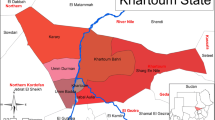Abstract
A cross-sectional serological survey was undertaken in selected districts of different agro-ecology of Jimma zone (Dedo, Yebu, Seka, Serbo, and Jimma town) from November 2009 to February 2010 to determine the seroprevalence of African horse sickness virus and associated risk factors of the disease. Two hundred seventy-four equids (189 horses, 43 mules, and 47 donkeys) with a history of non-vaccination for at least 2 years were selected randomly from the above areas. Sera samples were collected and assayed for the presence of specific antibody against African horse sickness virus using blocking ELISA. An overall seroprevalence of 89 (32.5%) was found and it was 24 (51.1%) for donkeys, 13 (30.2%) for mules, and 52(28.3%) for horses. Seroprevalence was significantly (X 2 = 11.05, P < 0.05) different among the different species of equids. Seroprevalence was also significantly (X 2 = 11.43, P < 0.05) different among the different agro-ecological areas being higher in highlands 47 (40.5%) followed by midland 30 (34.5%) and lowland 12 (16.9%). Age and sex were not significantly (X 2 = 3.15, P > 0.05 and X 2 = 3.38, P > 0.05, respectively) associated with seroprevalence of AHSV. The present study showed that African horse sickness (AHS) is highly prevalent disease for the horses followed by mules and then donkeys in Jimma zone explained by lower seroconversion rate. Therefore, control strategy against AHS should target at high risk species of all age and sex in their locality in the initial stage for better containment of the disease.
Similar content being viewed by others
References
Alemayehu, L. and Benti, D. 2009. Study on reproductive activity and evaluation of breeding soundness of jacks (Equus asinus) in and around Debre Zeit, Ethiopia, Livestock Research for Rural Development, 21, 2009
Central Statistical Authority (CSA), 2009. Federal Democratic Republic of Ethiopia, Central Statistical Authority (CSA), Agricultural Sample Survey 2008/2009 [2001E.C.], Report on Livestock and Livestock Characteristics (Privet Peasant Holdings), Addis Ababa, pp.120
FAO, 2003. Economic and social department, the statistical division, on line data base FAOSTAT 2003. http://www.Fao.org
Hyera, J.M. and Baipoledi, E.K., 2008. A serological survey of African horse sickness in Botswana, Journal of South African Veterinary Association, 79, 44–50
Kassa, D., 2006. African Horse Sickness: seroprevalence and identification of risk factors in equidae at selected sites in Ethiopia. (Unpublished MSc Thesis, Addis Ababa University, Faculty of Veterinary Medicine, Debre zeit)
Keith, R.P., 2005. Survey in to the factors affecting the health and welfare of donkeys and mules in Amhara and Tigray regions of northern Ethiopia, Report on the health and welfare of Donkeys and Mules to the Joint venture of Addis Ababa University Faculty of Veterinary Medicine, Debre Zeit, Ethiopia and the Donkey Sanctury, sidmouth, Devon, England, UK, pp. 68–81
Maclachlan, N. J. and Guthrie A. J., 2010. Re-emergence of bluetongue, African horse sickness and other Orbivirus diseases, Veterinary research, 41, 35
Mair, T.S., Divers, T. J. and Ducharme, N.G., 2002. Age determination: Manual of equine gastroenterology, 2nd edition, WB saunders, Elsevier science Ltd. Pp. 70–75.
Mellor, P. S., Baylis, M., Hamblin, C., Calisher, C. H. and Mertens, P.P.C., 1998. African Horse Sickness, http://www.Aphis.Usda.Gov/us/ep/fad
Meseret, B., 2007. Cross sectional seroepidemiological study of African Horse Sickness in selected site of two regional state of Ethiopia. (Unpublished DVM Thesis, Addis Ababa University, Faculty of Veterinary Medicine, Debre zeit)
Office International Des Epizootics (OIE), 2008. AHS in manual of diagnostic tests and vaccine for terrestrial animals, 5th ed., Paris: office international des epizootics, (W.B. saunders, Philadelphia), pp. 582–583
Radostits, O. M., Gay, C.C., Kenneth, W. and Hinchchliff, M., 2007. AHS in: Veterinary Medicine. A text book of the disease of cattle, sheep, pigs, goats and horses, 10th ed. (W. B. Saunders Company Ltd, New York) pp 867–882
Thrusfield, M., 2005. Veterinary Epidemiology, 3rd ed., (Blackwell science Ltd, UK), pp. 233–250
Venter, G.J., Koekemoer, J.J.and Paweska, J.T., 2006. Investigations on outbreaks of African horse sickness in the surveillance zone in South Africa, Revue Scientifique et Technique, 25, 1097–109
Wilson, A., Mellor, P. S. and Szmaragd, C. Mertens, P. P.C., 2009. Adaptive strategies of African horse sickness virus to facilitate vector transmission. Veterinary research, 40:1–16
Acknowledgements
The work has been conducted by the financial support of NARF/LV/01/008/09 project. The authors would like to thank Jimma University College of Agriculture and Veterinary Medicine for the collection of sera samples and questionnaire data. Much appreciation goes to the National Veterinary Institute of Ethiopia for the provision of laboratory facilities.
Author information
Authors and Affiliations
Corresponding author
Rights and permissions
About this article
Cite this article
Bitew, M., Andargie, A., Bekele, M. et al. Serological survey of African horse sickness in selected districts of Jimma zone, Southwestern Ethiopia. Trop Anim Health Prod 43, 1543–1547 (2011). https://doi.org/10.1007/s11250-011-9839-8
Accepted:
Published:
Issue Date:
DOI: https://doi.org/10.1007/s11250-011-9839-8




